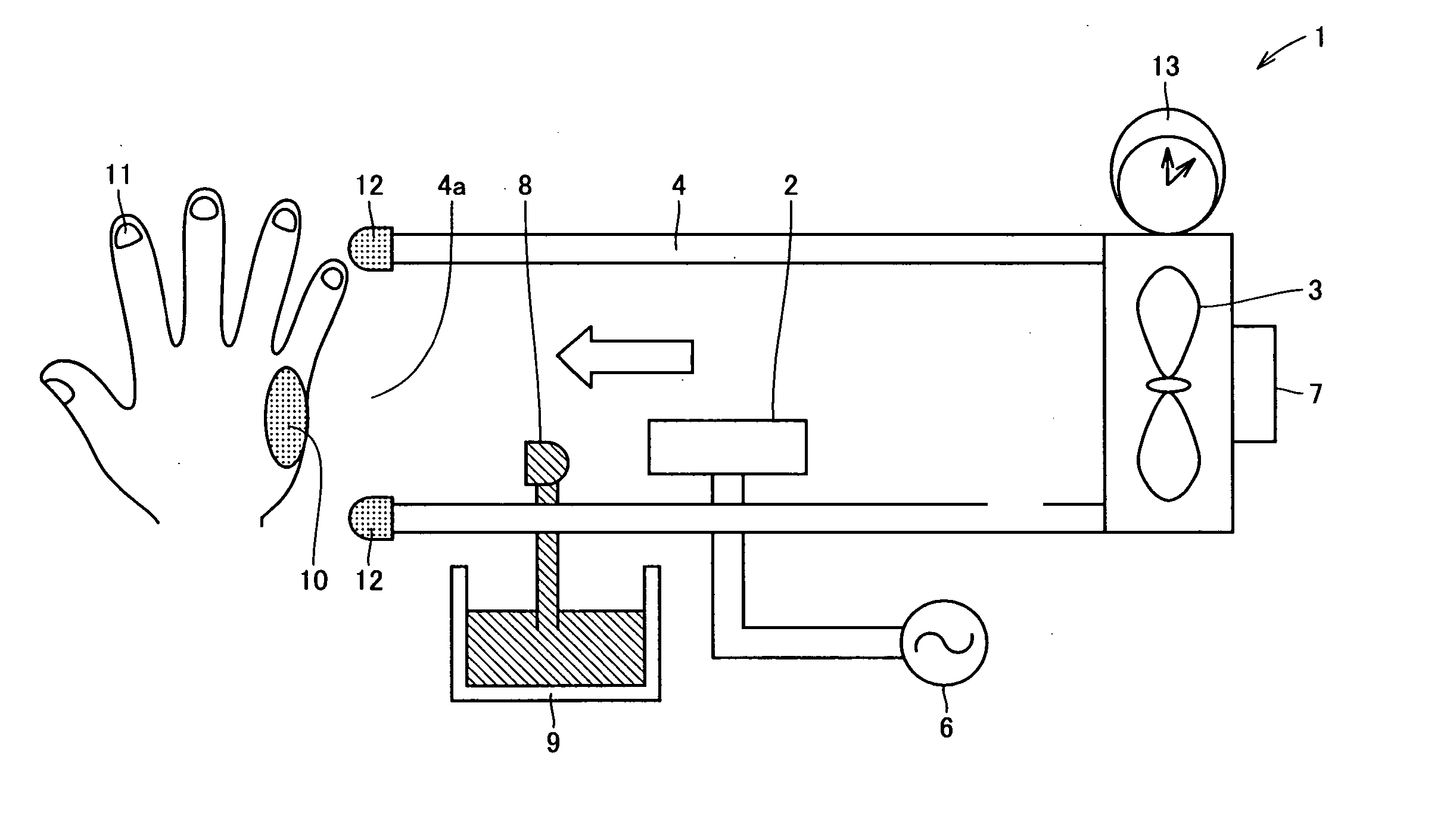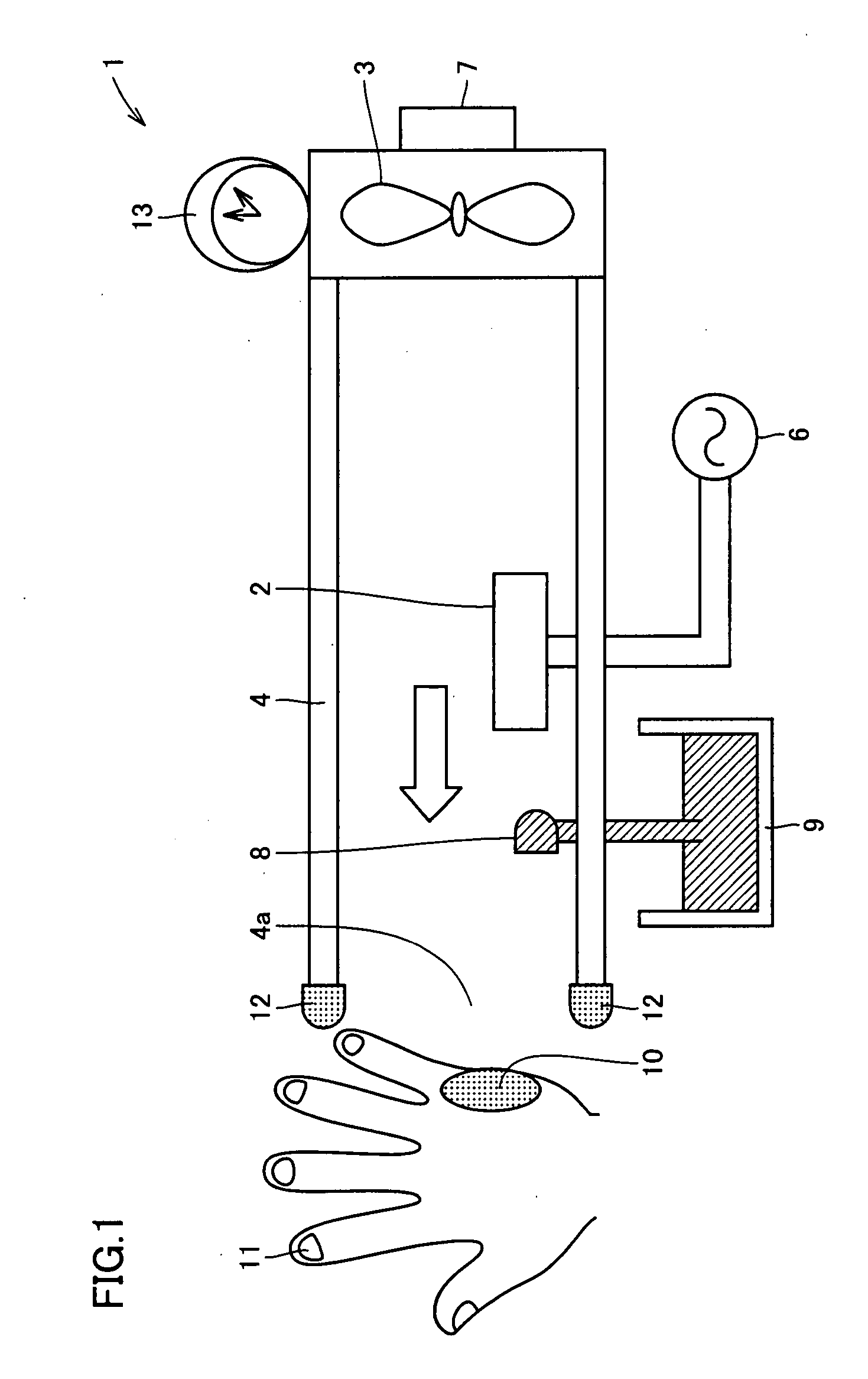Sterilization Method and Sterilization Apparatus
a sterilization method and sterilization technology, applied in the field of sterilization methods and sterilization apparatuses, can solve the problems of inability to completely and widely exert the sterilization effect of current sterilizing agents on all bacteria or viruses, skin allergy or physiological discomfort, and ozone not staying, so as to effectively and safely kill microorganisms or viruses, effectively and safely sterilize the affected area or mucosal area of an animal
- Summary
- Abstract
- Description
- Claims
- Application Information
AI Technical Summary
Benefits of technology
Problems solved by technology
Method used
Image
Examples
experimental example 1
[0071] Test conditions are shown below.
[0072] A test method used in Experimental Example 1 is summarized as follows. A bacterium was suspended in a PBS buffer solution (pH 7.4), and the suspension was inoculated onto an agar medium 34 contained in a tray 33. Thereafter, a predetermined treatment (that is, H3O+(H2O)n (where n is 0 or a natural number) and O2−(H2O)m (where m is 0 or a natural number) generated by electric discharge means were released as positive ions and negative ions, respectively, and these ions were naturally dispersed on the agar medium) was performed, and then tray 33 was incubated at 37° C. for 72 hours. After the completion of incubation, the number of colony forming units was counted. As a first test, a test for examining the sterilizing effect of electric discharge gas on various adhesive bacteria was performed. As adhesive bacteria, Staphylococcus, Enterococcus malodoratus, Sarcina flava, and Micrococcus roseus were used, and each of these bacteria was ino...
experimental example 2
[0094] In order to examine the sterilizing effect of air containing reactive particles on fungi, the same test as in Experimental Example 1 was performed on Penicillium chrysogenum, Stachybotrys chartarum, Asperigillus versicolor, Penicillium camambertii, and Cladosporium herbarum. FIGS. 5 to 9 are graphs showing the results of tests performed on Penicillium chrysogenum, Stachybotrys chartarum, Asperigillus versicolor, Penicillium camambertii, and Cladosporium herbarum, respectively. From the results of these tests, it has become clear that also in the case of fungi, the number of colony forming units (CFU) counted after incubation was smaller when the time for exposing each fungus to ions was longer.
experimental example 3
[0095] Fungi form spores resistant to thermal shock and physical attack, and therefore there is a fear that when fungi, beginning to form spores, are exposed to ions according to the sterilization method of the present invention, the spores block the ions to prevent decomposition of proteins of the fungi. Thus, Asperigillus versicolor and Cladosporium herbarum, which are very frequently observed in our living environment, were cultured in Petri dishes to once form spores, and then these fungi were exposed to ions for 4 hours in the same manner as in Experimental Example 1 to check to see whether any changes occurred. FIG. 10 is a photograph showing the result of the test performed on Asperigillus versicolor and Cladosporium herbarum in Experimental Example 3. As can be seen from FIG. 10, it was observed that exposure to ions inhibited further spore formation and caused disappearance of fungal colonies, as a result of the above test.
[0096] Then, the same test was performed on other ...
PUM
| Property | Measurement | Unit |
|---|---|---|
| size | aaaaa | aaaaa |
| frequency | aaaaa | aaaaa |
| pH | aaaaa | aaaaa |
Abstract
Description
Claims
Application Information
 Login to View More
Login to View More - R&D
- Intellectual Property
- Life Sciences
- Materials
- Tech Scout
- Unparalleled Data Quality
- Higher Quality Content
- 60% Fewer Hallucinations
Browse by: Latest US Patents, China's latest patents, Technical Efficacy Thesaurus, Application Domain, Technology Topic, Popular Technical Reports.
© 2025 PatSnap. All rights reserved.Legal|Privacy policy|Modern Slavery Act Transparency Statement|Sitemap|About US| Contact US: help@patsnap.com



